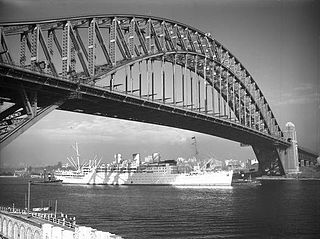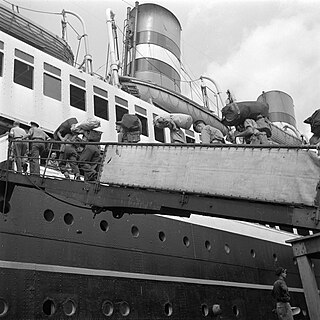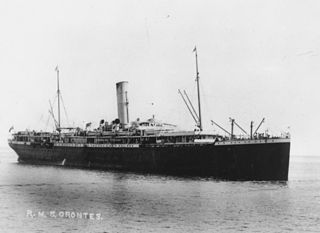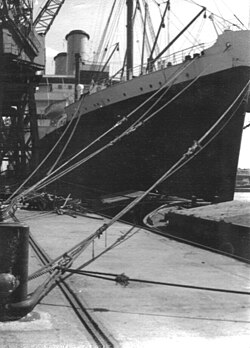Holland America Line is an American-owned cruise line, a subsidiary of Carnival Corporation & plc headquartered in Seattle, Washington, United States.

The Southern Railway (SR), sometimes shortened to 'Southern', was a British railway company established in the 1923 Grouping. It linked London with the Channel ports, South West England, South coast resorts and Kent. The railway was formed by the amalgamation of several smaller railway companies, the largest of which were the London and South Western Railway (LSWR), the London, Brighton and South Coast Railway (LB&SCR) and the South Eastern and Chatham Railway (SE&CR). The construction of what was to become the Southern Railway began in 1838 with the opening of the London and Southampton Railway, which was renamed the London & South Western Railway.

SS Canberra was an ocean liner, which later operated on cruises, in the P&O fleet from 1961 to 1997. She was built at the Harland and Wolff shipyard in Belfast, Northern Ireland at a cost of £17 million. The ship was named on 17 March 1958, after the federal capital of Australia, Canberra. She was launched on 16 March 1960, sponsored by Dame Pattie Menzies, wife of the then Prime Minister of Australia, Robert Menzies. She entered service in May 1961, and made her maiden voyage starting in June. She appeared in the 1971 James Bond film Diamonds Are Forever. In the 1982 Falklands War she served as a troopship. In 1997 the singer and songwriter Gerard Kenny released the single "Farewell Canberra" which was specially composed for the last voyage.

RMS Aquitania was a British ocean liner of the Cunard Line in service from 1914 to 1950. She was designed by Leonard Peskett and built by John Brown & Company in Clydebank, Scotland. She was launched on 21 April 1913 and sailed on her maiden voyage from Liverpool to New York on 30 May 1914. Aquitania was the third in Cunard Line's grand trio of express liners, preceded by RMS Mauretania and RMS Lusitania, and was the last surviving four-funnelled ocean liner. Shortly after Aquitania entered service, World War I broke out, during which she was first converted into an auxiliary cruiser before being used as a troop transport and a hospital ship, notably as part of the Dardanelles Campaign.

SS Ceramic was a steam ocean liner built in Belfast for White Star Line in 1912–13 and operated on the Liverpool – Australia route. Ceramic was the largest ship serving the route until P&O introduced RMS Mooltan in 1923.

SS Europa, later SS Liberté, IMO 5607332, was a German ocean liner built for the Norddeutsche Lloyd line (NDL) to work the transatlantic sea route. She and her sister ship, Bremen, were the two most advanced, high-speed steam turbine ocean vessels in their day, with both earning the Blue Riband.

SSOriana was the last of the Orient Steam Navigation Company's ocean liners. She was built at Vickers-Armstrongs, Barrow-in-Furness, Cumbria, England and launched on 3 November 1959 by Princess Alexandra. Oriana first appeared as an Orient Line ship, with a corn-coloured hull, until 1966, when that company was fully absorbed into the P&O group. Faced with unprofitable around-the-world passenger routes, the P&O white hulled Oriana was operated as a full-time cruise ship from 1973. Between 1981 and her retirement from service five years later, Oriana was based at Sydney, Australia, operating to Pacific Ocean and South-East Asian ports. Deemed surplus to P&O's requirements in early 1986, the vessel was sold to become a floating hotel and tourist attraction, first in Japan and later in China. As a result of damage sustained from a severe storm whilst in the port of Dalian in 2004, SS Oriana was finally sold to local breakers in 2005.

The SS Mongolia was a steam turbine-driven twin-screw passenger-and-cargo ocean liner launched in 1922 for the Peninsular and Oriental Steam Navigation Company (P&O) for service from the United Kingdom to Australia. Later in P&O service she sailed for New Zealand, and in 1938 she was chartered to a P&O subsidiary, the New Zealand Shipping Company, as SS Rimutaka.

SS Argentina was a US turbo-electric ocean liner. She was completed in 1929 as SS Pennsylvania, and refitted and renamed as SS Argentina in 1938. From 1942 to 1946 she was the War Shipping Administration operated troopship Argentina. She was laid up in 1958 and scrapped in 1964.

SS Gothic was a passenger-cargo liner launched in December 1947, though not completed until a year later. She became the most famous of the quartet when she was designated a royal yacht from 1952 to 1954.

RMS Strathaird, later TSS Strathaird, was an ocean liner of the Peninsular and Oriental Steam Navigation Company (P&O).

SSLurline was the third Matson Lines vessel to hold that name and the last of four fast and luxurious ocean liners that Matson built for the Hawaii and Australasia runs from the West Coast of the United States. Lurline's sister ships were SS Malolo, SS Mariposa and SS Monterey. Lurline served as a troopship in World War II operated by War Shipping Administration agents serving Army troop transport requirements. Bought by the Chandris Lines in 1963 as the RHMS Ellinis the ship became one of the most important luxury cruise ships on the Australian and New Zealand services. She operated in Australasia and Oceania until 1980. The sister ships of the SS Lurline were the SS Palo Alto and SS Oakland.

SS Duchess of Richmond was an ocean liner built in 1928 for Canadian Pacific Steamships by John Brown & Company in Clydebank, Scotland. In 1947 she was renamed SS Empress of Canada.

RMS Orion was an ocean liner launched by the Orient Steam Navigation Company in 1934 and retired from the water in 1963 after carrying about 500,000 passengers. A 23,371 ton passenger ship, the Orion was built to carry 486 first class, 653 tourist class and 466 crew passengers from Europe through the Pacific to Australia. The construction of the ship was documented in Paul Rotha's 1935 film Shipyard.

Lavia was a cruise ship that caught fire and sank in Hong Kong Harbour in 1989. She was built for Cunard White Star Line in 1947 as the cargo liner Media. In 1961 she was sold to Italy, rebuilt as an ocean liner and renamed Flavia. In 1969, she was refitted as a cruise ship and renamed Flavian. In 1982 she was sold to Panama and renamed Lavia. She was undergoing a refit when the fire occurred. The damage to her was so great that she was scrapped.

SS Iberia was an ocean liner completed in 1954 for the Peninsular and Oriental Steam Navigation Company (P&O). Along with her fleetmates Himalaya, Arcadia and Chusan, Iberia mainly provided passenger service between the United Kingdom and Australasia.

RMS Strathnaver, later SS Strathnaver, was an ocean liner of the Peninsular and Oriental Steam Navigation Company (P&O).

SS Volendam was a 15,434 GRT ton ocean liner operated by Holland America Line. She was built in 1922 by Harland & Wolff Ltd, in Govan, Glasgow. Her 15,450 GRT sister ship TSS Veendam was built by Harland & Wolff the following year. She operated on transatlantic routes between Europe and the USA, sailing the Rotterdam – New York and Rotterdam – Halifax service.

RMS Orontes was a steam ocean liner of the Orient Steam Navigation Company that was launched in 1902 and scrapped in 1925.

RMS Orama was a UK steam ocean liner and Royal Mail Ship. She was launched in 1911 for the Orient Steam Navigation Company. When new, she was the largest liner sailing between Great Britain and Australia.




















